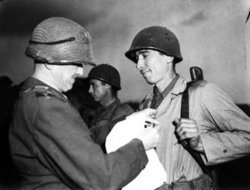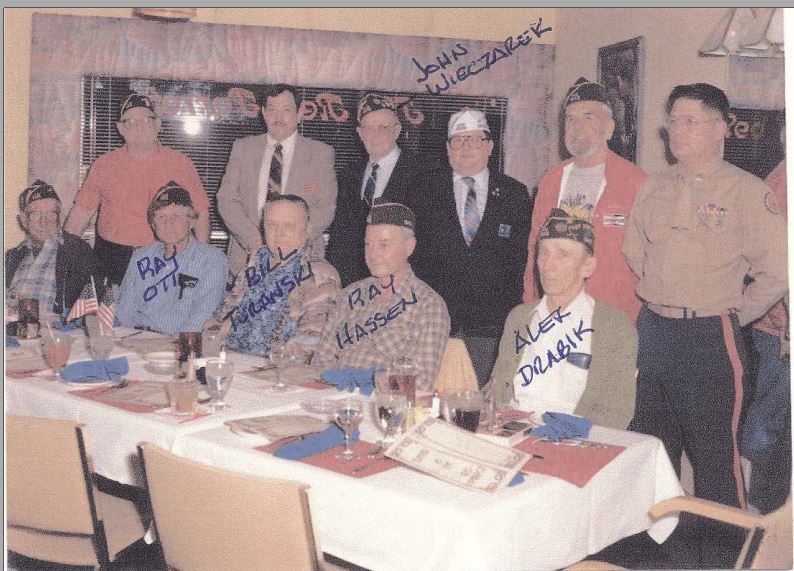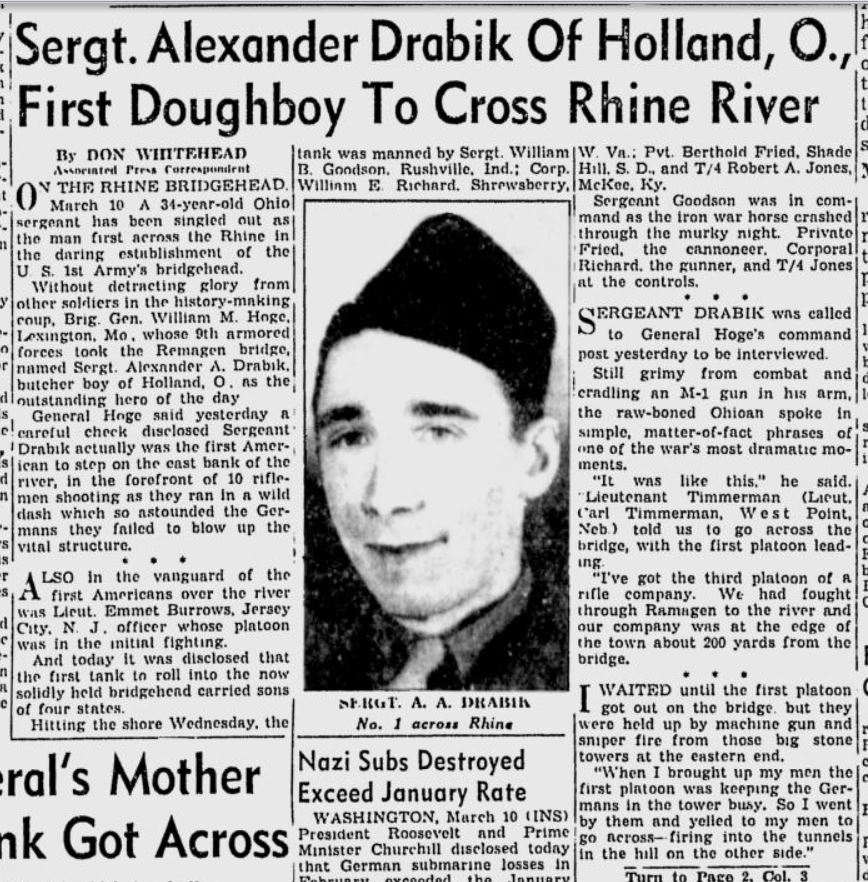Alexander Drabik: Hero of Remagen Bridge
Per the Holland Springfield Spencer Historical Society, Alexander Drabic was born on December 28, 1910 in a log cabin on Wolfinger Road to John Drabik and Florence Lewandowski. He lived most of his life in Holland, Ohio on Dorr Street. He married Margaret Feeney, May 14, 1954 in Angola, Indiana and they had one daughter.
Alexander was reported as a quiet, humble man who was tall, lanky, and shy. An unlikely hero. Matthew Reed, the principal in his elementary school said in a 1955 interview that “He was a big boy in school. Although he never once started a fight, lost of times, I saw him beating up bullies who pestered the smaller kids. Once he got an idea, he never let up, that’s why I’m not surprised about his heroism.” Alexander was also described as “modest but fearless.”
He was living in Holland, Ohio and working as a butcher at Folgers Meats when he joined the US Army in 1942 and was sent to Fort Riley, Kansas for basic training with the 9th Armored Division and then on to maneuvers in Louisiana and California. He distinguished himself by rescuing 120 recruits who had become lost in the California desert. Soon after, he was sent to the European Theatre.
Drabik was at the Battle of the Bulge and seriously wounded by artillery fire but would not be evacuated and stayed with his men until the siege was lifted. The Battle of the Bulge was Adolph Hitler’s last counter-offensive, an attempt to sop the American Army by cutting off their supply port in Antwerp, Belgium. When that failed, Americans continued their advance to the Rhine and into Germany. Hitler refused his army to withdraw across the Rhine and to set up defensive positions on the east bank. When it was realized that the Germans were losing men and equipment at an alarming rate, Hitler allowed his army to draw back but also directed that all bridges must be destroyed after German forces had crossed. As the Americans advanced without bridges, pontoon bridges needed to be built while the German setup defensive positions on the east bank. The Rhine River posed a great obstacle to the Allies. It was sometimes as much as a mile wide, with swift currents and high banks. The high banks afforded the Germans the ability to inflict great losses.
As Americans arrived at the Rhine, they would attempt to seize a bridge to bring men, tanks, and artillery into the heart of German. They failed to capture the Hohenzollern Bridge at Cologne, it was blow up just before the Americans arrived. An attempt at Dusseldorf also failed, the bridge was blown up just as tanks approached the bridge. A third attempt was made at Urdigen and failed.
On 7 March 1945, the 9th Armored Division arrived at Remagen on the Rhine. From the west bank, they saw that the Ludendorff railroad bridge was still standing. German forces were still retreating over the bridge and were awaiting a German artillery unit.
The bridge was being prepared for demolition when Americans raced to seize it. The bridge was blown and the explosion lifted the bridge but it miraculously settled back on it’s foundation and remained intact. The Germans prepared for another demolition as an American squad rushed onto the bridge and were pinned down by heavy fire from the east bank. Sgt. Drabik and his squad then set up defensive positions, preventing the Germans from a second attempt at destroying the bridge.
The squad ran the entire length of the bridge span, which was 250 yards long. Drabik later would say “it was the longest run of my life.”
After reaching the east bank of the river, Drabik captured a German soldier. Instead of sending him back to an uncertain fate, likely to face an overzealous American GI, he kept the German with him. The German dug a foxhole where they had spent the night. In the morning, he had the German escorted over the bridge to the west bank as a POW, most likely saving his life.

For this heroism, Drabik and his men were awarded the Distinguished Service Cross, this nation’s second highest honor (the Congressional Medal of Honor is the highest). Years later, the German that Drabik had saved, a Captain Friesenhahn, was told that Sgt. Drabik and his men received the Distinguished Service Cross. Friesenhahn, who escaped Hitler’s wrath, said “They certainly deserve it. They saw us trying to blow up the bridge, and by all odds, it should have blow up while they were crossing it. In my mind, they are the greatest heroes in the whole war.”
Drabik was discharged from the army a few months later on 12 October 1945 after World War II ended. He wished for nothing more than a quiet life with his family. Drabik did live that life quietly, for the most part. However, he was brought to national attention several times at major anniversaries of or events surrounding the capture of the Remagen Bridge.
In 1955, at the tenth anniversary, he and his squad were invited to the White House by President Eisenhower. Eisenhower announced the formation of the Society of the Remagen Bridgehead and presented Drabik with a picture of the bridge depicting the action of 7 March 1945. An inscription on the picture read: “In commemoration of the tenth anniversary of the siezure of the Remagen Bridge at Remagen, Germany on March 7, 1945 by the 9th Armored Division.” Eisenhower remarked that no one thought it could be done and that “it typified the dash of ingenuity, the readiness at the first opportunity, that characterizes the American Soldier.”

Two years later, Drabik was again in Washington DC for a reunion of the Society of the Remagen Bridgehead.
In 1970, he was again invited to the White House by Presi8dent Richard Nixon for the 25th anniversary of Remagen. That same year, Drabik was elected Commander of the Turanski-Van Glahn VFW Post 7372. He held that position for seven years and the post was renamed to the Remagen Bridge Post in honor of Drabik. Later that year he was also invited to Washington to view a war film about Remagen. While honored to be invited, Drabik was unhappy with the Hollywood version.
In 1985, on the 40th anniversary of Remagen, Drabik met the German soldier whose life he saved. The man was there to express his gratitude. “If it were not for you, I wouldn’t be here today.”
Drabik continued to work for Folgers Meats as a butcher for sometime and then took on employment with a cement company, finally retiring in 1978. Starting in 1987, Drabik and other surviving members of his unit would go to Fort Leavenworth each year as guests for the annual Armor and Calvary Ball. He met his death on the journey to the ball in 1993, when his car crashed into a tractor-trailer rig on I-70 in Missouri. He died on 23 September 1993 and is buried in Resurrection Cemetery. On 24 April 2015, Drabik was posthumously inducted into the Ohio Military Hall of Fame for Valor at the Statehouse Atrium in Columbus, Ohio.
In 2020, a stretch of I-475/US23 between Hill Ave. and State Route 2 was dubbed “Sgt. Alex Drabik Memorial Highway” in Drabik’s honor. This stretch of road was selected because it runs through the area of Lucas County where Alex Drabik grew up.

The source of much of this article is from the University of Toledo, Ward M. Canaday Center for Special Collections, The Veterans History Project.